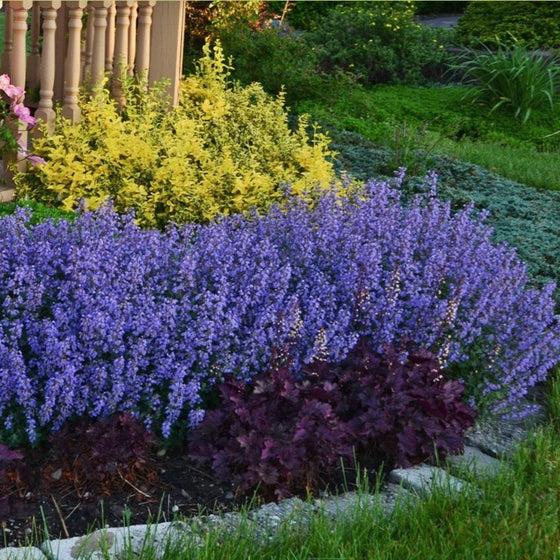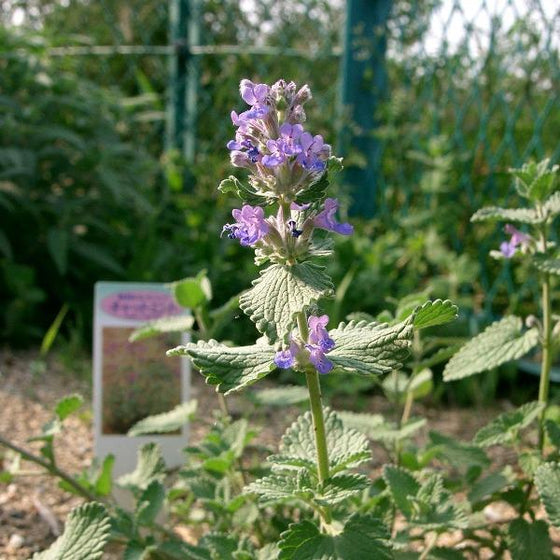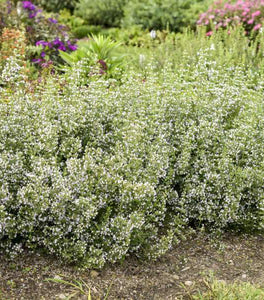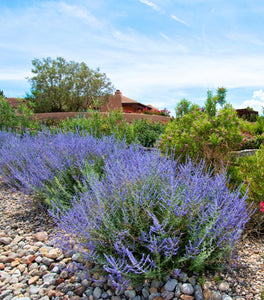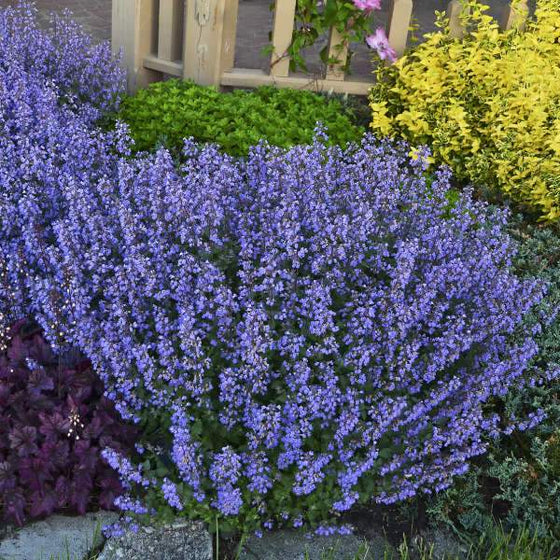
Images Depict Mature Plants
Purrsian Blue Catmint
Purrsian Blue Catmint (Nepeta faassenii ‘Purrsian Blue’) is a compact, mounding perennial prized for its soft, aromatic gray-green foliage and profusion of violet-blue flower spikes that bloom from late spring through summer. This low-maintenance, drought-tolerant plant grows just 12 to 18 inches tall and forms a tidy clump, making it ideal for the front of borders, along walkways, or in mixed perennial beds. Its fragrant leaves and long-lasting blooms attract pollinators like bees and butterflies, while its tidy habit and vibrant color provide months of garden interest.
Unlike some taller catmints, Purrsian Blue holds its shape beautifully and resists flopping, even during peak bloom. It thrives in full sun and well-drained soil, performing reliably in dry, rocky, or poor soils where other perennials may struggle. This deer- and rabbit-resistant perennial is also highly heat-tolerant, making it a dependable choice for hot, sunny landscapes or xeriscape designs. With minimal care—just occasional deadheading or a mid-season trim—Purrsian Blue Catmint will reward you with a second flush of blooms and tidy, silvery foliage.
Perfect for pollinator gardens, cottage borders, and container plantings, Purrsian Blue Catmint delivers color, fragrance, and texture with very little effort. It pairs beautifully with roses, lavender, coreopsis, and ornamental grasses, creating a colorful and dynamic landscape composition. Whether you're designing a water-wise garden or enhancing a sunny flower bed, Purrsian Blue offers exceptional performance, long bloom time, and year-after-year reliability in both residential and commercial settings.

| Hardiness Zone: | 3-8 |
|---|---|
| Mature Height: | 1 to 1.5 Feet |
| Mature Width: | 1.5 to 2 Feet |
| Classification: | Perennial |
| Sunlight: | Full sun |
| Habit: | Spreading, clump forming |
| Flower Color: | Bluish purple |
| Flowering Season: | Late May through September |
| Foliage: | Blue-green fragrant foliage |
| Soil Condition: | Prefers dry, average to sandy soil |
| Water Requirements: | Water well until established |
| Uses: | Extremely attractive when used as a focal point in the mixed border, mass planting; attracts pollinators |
How to Care for Purrsian Blue Catmint
Before you buy a Purrsian Blue Catmint Plant, make sure to read about the recommended care instructions to keep this plant healthy and thriving.
How do I plant a Purrsian Blue Catmint Plant?
To plant a Purrsian Blue Catmint (Nepeta faassenii ‘Purrsian Blue’), choose a location that receives full sun and has well-drained soil, as this drought-tolerant perennial thrives in hot, dry conditions. Begin by digging a hole twice as wide and just as deep as the plant’s root ball. Gently remove the catmint from its container, loosen any circling roots, and place it in the hole so the top of the root ball is level with the surrounding soil. Backfill with native soil, pressing down gently to eliminate air pockets, and water thoroughly to help the plant settle in. Space Purrsian Blue Catmint plants about 18 to 24 inches apart to allow for their natural mounding habit and airflow between plants. After planting, apply a light layer of mulch to conserve moisture and suppress weeds, but keep it a few inches away from the crown to prevent rot. Water regularly during the first growing season to establish deep roots, then reduce frequency as the plant matures. With its compact growth, aromatic foliage, and long-lasting violet-blue blooms, Purrsian Blue Catmint is perfect for edging sunny borders, filling in rock gardens, or softening the edges of walkways and patios.
How do I water a Purrsian Blue Catmint Plant?
Watering a Purrsian Blue Catmint (Nepeta faassenii ‘Purrsian Blue’) properly is key to establishing a healthy, long-blooming plant that thrives in sunny, dry conditions. During the first growing season, water deeply once or twice a week to help the plant develop a strong root system. Focus on soaking the soil thoroughly rather than frequent shallow watering, which encourages weak, surface-level roots. Always check that the soil has dried slightly between waterings, as catmint prefers well-drained soil and does not tolerate soggy conditions. Once established, Purrsian Blue Catmint becomes highly drought tolerant and generally only requires supplemental watering during extended dry spells or periods of extreme heat. Mulching around the base of the plant helps retain soil moisture and reduces the frequency of watering while also preventing weed competition. Avoid overhead watering, as wet foliage can encourage mildew; instead, use a soaker hose or direct water at the soil level. With minimal watering needs and a strong resistance to heat and drought, this fragrant, pollinator-friendly perennial is a reliable and easy-care choice for low-maintenance landscapes
How do I fertilize Purrsian Blue Catmint Plants?
Fertilizing Purrsian Blue Catmint (Nepeta faassenii ‘Purrsian Blue’) is simple and minimal, as this hardy perennial thrives in lean, well-drained soils. In early spring, apply a light dose of balanced, slow-release fertilizer—such as a 10-10-10 blend—around the base of the plant to support healthy growth and abundant flowering. Avoid over-fertilizing, as excessive nutrients can lead to lush foliage at the expense of blooms and may reduce the plant’s naturally compact form. Water thoroughly after fertilizing to help nutrients soak into the root zone. For gardeners who prefer organic methods, a light application of compost or well-aged manure in spring can provide a gentle nutrient boost while improving soil structure. Purrsian Blue Catmint generally does not require additional feeding throughout the season, especially in nutrient-rich soils. Too much fertilizer can cause floppy growth and reduce the drought tolerance that makes this perennial so desirable. With just a touch of spring fertilization and regular sun exposure, Purrsian Blue Catmint will reward you with a long season of fragrant, violet-blue blooms ideal for pollinator gardens, borders, and dry, sunny landscapes.

How and When Should I Prune my Purrsian Blue Catmint?
Pruning your Purrsian Blue Catmint (Nepeta faassenii ‘Purrsian Blue’) at the right time keeps the plant compact, encourages repeat blooming, and maintains its tidy, mounding shape. The best time for major pruning is in early summer, after the first wave of violet-blue blooms has faded. Simply shear back the plant by about one-third to remove spent flower spikes and stimulate fresh growth. This quick trim helps rejuvenate the foliage and often triggers a second flush of flowers that will carry the plant through late summer and into fall. In early spring, cut back any winter-damaged stems to just a few inches above the soil, allowing fresh new growth to emerge cleanly. Throughout the growing season, you can perform light shaping as needed to maintain the plant’s form, especially if it begins to sprawl. Because Purrsian Blue Catmint is resistant to deer and drought, minimal maintenance beyond strategic pruning is required to keep it thriving. Regular trimming enhances flower production, keeps the plant dense and bushy, and helps it shine in sunny borders, pollinator gardens, and low-maintenance landscapes.

